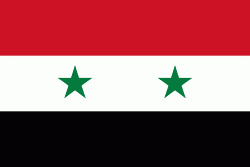Al-Haffah District (Al-Haffah District)
Al-Haffah District is a district of the Latakia Governorate in northwestern Syria. Administrative centre is the city of al-Haffah. At the 2004 census, the district had a population of 81,213.
Al-Haffah District is located in the area of An-Nusayriyah Mountains east of Lattakia city. It is an important trading centre where local farmers sell their apple fruits and other products. It has a significant historical importance as it was one of the main strategic points of the invading Crusaders. It is home to the Salah Ed-Din Castle; a UNESCO World Heritage Site.
With its Mediterranean fir forests and mild temperature in summer, the district is also one of the popular tourist destinations in Syria. Many mountainous resorts are located in the district, mainly in the town of Slinfah.
The district of al-Haffah is divided into five sub-districts or nawāḥī (population as of 2004 ):
* Al-Haffah Subdistrict (ناحية الحفة): population 23,347.
* Slinfah Subdistrict (ناحية صلنفة): population 19,518.
* Ayn al-Tineh Subdistrict (ناحية عين التينة): population 6,825.
* Kinsabba Subdistrict (ناحية كنسبّا): population 17,615.
* Muzayraa Subdistrict (ناحية مزيرعة): population 13,908.
Al-Haffah District is located in the area of An-Nusayriyah Mountains east of Lattakia city. It is an important trading centre where local farmers sell their apple fruits and other products. It has a significant historical importance as it was one of the main strategic points of the invading Crusaders. It is home to the Salah Ed-Din Castle; a UNESCO World Heritage Site.
With its Mediterranean fir forests and mild temperature in summer, the district is also one of the popular tourist destinations in Syria. Many mountainous resorts are located in the district, mainly in the town of Slinfah.
The district of al-Haffah is divided into five sub-districts or nawāḥī (population as of 2004 ):
* Al-Haffah Subdistrict (ناحية الحفة): population 23,347.
* Slinfah Subdistrict (ناحية صلنفة): population 19,518.
* Ayn al-Tineh Subdistrict (ناحية عين التينة): population 6,825.
* Kinsabba Subdistrict (ناحية كنسبّا): population 17,615.
* Muzayraa Subdistrict (ناحية مزيرعة): population 13,908.
Map - Al-Haffah District (Al-Haffah District)
Map
Country - Syria
 |
 |
| Flag of Syria | |
The name "Syria" historically referred to a wider region, broadly synonymous with the Levant, and known in Arabic as al-Sham. The modern state encompasses the sites of several ancient kingdoms and empires, including the Eblan civilization of the 3rd millennium BC. Aleppo and the capital city Damascus are among the oldest continuously inhabited cities in the world. In the Islamic era, Damascus was the seat of the Umayyad Caliphate and a provincial capital of the Mamluk Sultanate in Egypt. The modern Syrian state was established in the mid-20th century after centuries of Ottoman rule. After a period as a French mandate (1923–1946), the newly-created state represented the largest Arab state to emerge from the formerly Ottoman-ruled Syrian provinces. It gained de jure independence as a democratic parliamentary republic on 24 October 1945 when the Republic of Syria became a founding member of the United Nations, an act which legally ended the former French mandate (although French troops did not leave the country until April 1946).
Currency / Language
| ISO | Currency | Symbol | Significant figures |
|---|---|---|---|
| SYP | Syrian pound | £ or لس | 2 |
| ISO | Language |
|---|---|
| AR | Arabic language |
| HY | Armenian language |
| EN | English language |
| FR | French language |
| KU | Kurdish language |















